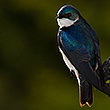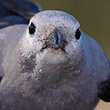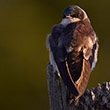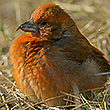
Availability: Limited Edition Print; RM Stock (??)
In the Field
Finding First Light. Findlay Creek, BC, Canada. May 25, 2005.
One of the main reasons I shoot almost exclusively digitally these days is the huge "brightness range" (or dynamic range) that can be captured in an image. This image is of a female Tree Swallow at sunrise. The bird was extremely strongly sid-lit - the right side of the bird was in brilliant sunshine and the left side in the darkest shadows. With film, I could have captured the bright highlights or the dark shadows, but not both. And, incidentally, with my naked eye I could make out detail in both the shadows and highlights and wanted to ensure my final image did so too.
So how do you capture such a wide dynamic range using digital technologies? There are many details associated with the process, but here's the key points: 1) shoot RAW format images (JPEG's are convenient but capture a much narrower range of brightness); 2) expose your image for the highlights (i.e., don't overexpose the highlights); 3) retrieve the shadow detail using a combination of your RAW converter and image editing program. For additional details, see Bio: Techniques.
Behind the Camera
Finding First Light. Findlay Creek, BC, Canada. May 25, 2005.
Digital Capture; Compressed RAW (NEF) format; ISO 100.
Nikon D2X with Nikon 200-400 mm f/4G ED-IF AF-S VR lens @ 400 mm (600 mm equivalent with digital conversion factor) supported on Gitzo 1348 carbon fibre tripod with Wimberley head. VR turned to "On" and in "Normal" mode.
1/125s @ f6.3; -1.33 stop exposure compensation from matrix-metered exposure setting.
At the Computer
Finding First Light. Findlay Creek, BC, Canada. May 25, 2005.
RAW Conversion, including first-pass sharpening, exposure compensation, and tone curve adjustment, using Phase One's C1 Pro. Multiple RAW conversions (2 at different exposure settings) to extend dynamic range of captured image, in this case primarily to restore shadow detail on shaded portions of bird (along the entire left side of the bird).
All further digital correction on 16-bit TIFF file using Adobe's Photoshop CS, including compositing and masking of various exposure versions, selective saturation enhancement, and selective sharpening for web output.
Conservation
Finding First Light. Findlay Creek, BC, Canada. May 25, 2005.
Ten percent of the revenue generated by this image will be donated to Wildsight.
Species Status in Canada*: This species is not designated as at risk.
The Tree Swallow (Tacycineta bicolor) is a common insect-eating aerobatic specialist found across much of North America. Tree Swallows nest in abandoned cavities in trees or in nest boxes provided for them by humans. The breeding range of the Tree Swallow is expanding southward and overall their populations appear to be increasing.
This female Tree Swallow was photographed in the Columbia Valley of the East Kootenays. While this species is not considered at risk in any way, many ecosystems within the Columbia Valley face development pressure. Wildsight is an effective conservation organization that protects biodiversity and promotes sustainable communities in Canada's Columbia and Rocky Mountains. Support for Wildsight, through donation or becoming a member, will help ensure that they remain effective in their efforts to conserve threatened or endangered species and ecosystems.
*as determined by COSEWIC: The Committee on the Status of Endangered Wildlife in Canada

























